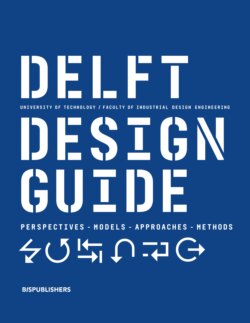Читать книгу Delft Design Guide -Revised edition - Annemiek van Boeijen - Страница 30
На сайте Литреса книга снята с продажи.
ОглавлениеWhat & Why? In design projects, usually both individual and universal values and needs are examined. The cultural perspective is often forgotten or implicitly included. However, the cultural context influences the perception of design in a two-way fashion.
In a globalized world with interconnected societies and with the complexity of multicultural subgroups, designers are confronted with the challenge of people sharing different beliefs, values, and practices. This may be seen as a problem needing to be tackled in order to avoid cultural mistakes. It can also be seen as a positive attitude change towards people living in different cultural contexts (such as different regions, professions, or families) or people dealing with different situ- ations, climates, economic situations, demography, and politics.
Culture-sensitive designers are aware not only of the cultural context that they design for but also the influence of their own cultural backgrounds on their design.
----------------------------------------------------------------------------------------------------------
Mindset: Developing cultural awareness and sensitivity can only result from a curious attitude, an open mind, and a broad social and historical interest. CSD requires you to reflect on your own cultural background to understand how it influences your values and beliefs, as well as what it means for your own work.
----------------------------------------------------------------------------------------------------------
28. Culture-Sensitive Design
How? CSD offers models that help designers sharpen their lens in looking at culture, appropriating existing methods, or exploring cultural contexts. Theories are adopted from other disciplines such as anthropology, design history, and sociology, and these are attuned to the designer’s needs. An example is the circuit of culture, a comprehensive model that entails five processes that influence the cultural meaning of things: these processes are production of meaning, consumption (daily practices), social
regulation, representation by media, and identity.
In line with Persona, a new method called Cultura has been developed that helps designers gain insights into people’s cultural contexts and build intercultural empathic under- standing in the early stages of a new product or service development. A set of sociocultural dimensions and the Crossing Culture Chasms card set can help designers raise culture-specific questions and generate ideas based on specific value orientations.
Culture-Sensitive Design
References & Further Reading: du Gay, P., Hall, S., Janes, L., Mackey, H., & Negus, K., 1997. Doing Cultural studies: The Story of the Sony Walkman . London: Sage Publications (in association with the Open University). / Hao, C., van Boeijen, A.G.C., & Stappers, P.J., 2017. Generative research techniques crossing cultures: a field study in China. International Journal of Cultural and Creative Industries. / van Boeijen, A.G.C., 2015. Crossing Cultural Chasms: Towards a culture-conscious approach to design. Doctoral Thesis, Delft University of Technology, Delft. / van Boeijen, A.G.C., 2020. Culture Sensitive Design: A guide to culture in practice. Amsterdam: BIS Publishers.
Tips & Concerns
Culture is a comprehensive term that is not easy to delineate and cannot be cast into concrete. Therefore, you need an open and flexible mind and a broad interest.
--------
Individuals often do not consider themselves as representatives of a cultural group. A helpful analogy is the forest: we can classify a group of trees into different types of forests, such as a tropical rain forest or a Mediterranean forest. While each type is different, together they have something in common.
--------
Culture-sensitivity helps you attune your design research methods to intended users and to develop your own stance regarding what your design should do in the cultural context.
--------
It also helps you specify who is or isn’t included in the context.
------------------------------------------
Limitations
CSD is based on viewing people as members of groups; therefore, less attention is given to individual differences.
--------
It does not highlight what most individuals have in common, such as the universal principles of human behaviour.
--------
To avoid blunders, culture-sensitivity should be incorporated into regular design processes.
Culture-Sensitive Design (CSD) is a perspective that highlights the influence of culture regarding a designer’s background, the process of designing, and the generated designs. A sensitive ‘eye’ for the cultural context helps with finding opportunities and overcoming barriers due to cultural influences.
perspectives
---------------------------------------------------------------------------------------------------------------------------------------------------------------
29
